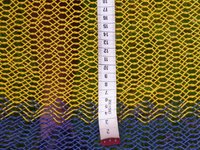Home page Hammocks Information about hammocks Quality
Quality

How to Recognize a Good Hammock?
The most significant criterion for quality is the size of a hammock. The larger it is, the more comfortable. Hence, I exclusively offer hammocks in the very spacious and comfortable 'Matrimonial' and 'Familiar' sizes. Apart from size, the weave density of a hammock significantly affects its comfort. Additionally, good hammocks are characterized by a high number of lying threads per carrying thread. The material from which the hammock is made also plays a crucial role in its characteristics. Naturally, handcrafted hammocks hold higher value compared to factory-made ones. Lastly, the experience and tradition of the weavers contribute to the quality.
Size
Refer to the section on different sizes of Mexican hammocks. I exclusively offer very large hammocks in the 'matrimonial' and 'familiar' sizes. The length of individual hammocks doesn't differ, only the widths do. Since one usually lies diagonally or crosswise, the width is the decisive factor for comfort. In general, the larger the hammock, the more space and comfort it provides.
Weave Density / Mesh Size
The second important quality criterion is the weave density. The denser the hammock's weave, the more comfortable and soft it is to lie on. The tighter the weave, the better it contours to the body shape when lying down.
In the case of very loosely woven net hammocks from German supermarkets, it's possible for individual threads to dig into the skin, leaving impressions when one gets up. This is not a concern with Mexican net hammocks.
The hammocks from the vicinity of Merida are undisputedly the finest and most tightly woven in all of Mexico. For instance, if you purchase a hammock from a souvenir shop in Mexico City or Acapulco or compare it with those from a reputable hammock vendor in Merida, you will notice the difference at first glance.
Of course, the denser the weave of a hammock, the more work is put into it, and subsequently, the more expensive and valuable it is. I exclusively offer densely woven, high-quality hammocks from the area around Merida in Yucatan.
Number of Lying Threads
An important quality criterion that weavers often emphasize is the number of lying threads attached to a carrying thread. Lower quality hammocks frequently have only two lying threads attached to a carrying thread. High-quality hammocks can be recognized by having at least three lying threads per carrying thread. Ultimately, this affects the weave density. Naturally, weaving three threads instead of one or two is more labor-intensive. All my hammocks are woven with three lying threads per carrying thread.
Thread Thickness
In general, the finer the thread thickness, the more comfortable and sturdy the hammock is. The latter might sound counterintuitive at first. This is because hammocks with finer threads are usually woven more tightly and have more threads, making them more comfortable. I offer hammocks with fine thread thickness, and for the 'matrimonial' size, I also have some with medium thread thickness. In this case, individual threads are slightly more tear-resistant in case they get caught on a button or a watch.
Material
Hammocks are made from three different materials:
- Cotton
- Synthetic (Nylon)
- Sisal
Sisal (fiber from the Mexican Sisal Agave) is the traditional material. The agave is named after the city of the same name in Yucatan, which was a thriving port city exporting sisal worldwide before the emergence of cotton fabrics. Sisal is rarely used today as its threads are not as stable as cotton threads and cannot be dyed. Anyone who has ever lain in a sisal hammock knows that it can be slightly scratchy on the skin. Hence, I don't offer sisal hammocks. Unbleached cotton hammocks are often mistakenly sold as traditional hammocks, although they appear somewhat dull compared to the colorful and vibrant ones.
Synthetic (nylon) has the advantage that the colored synthetic threads have particularly vibrant colors. Additionally, color fastness in the sun is higher, and the material is more weather-resistant. However, synthetic isn't as skin-friendly or comfortable; you're more likely to sweat in the hammock. They are coarser woven and significantly heavier than cotton hammocks.
For cotton hammocks, the sleeping surface is made of cotton threads, and the carrying threads are made of slightly sturdier nylon. This makes the sleeping surface particularly comfortable and skin-friendly. Even cotton hammocks can stay outside for extended periods and are very colorful. In my view, they are the best choice, and hence, I offer cotton hammocks. However, cotton hammocks are not permanently weatherproof and should be protected, especially from continuous rain, either by a terrace or balcony covering or by taking them down temporarily.
Handcrafting
All my hammocks are meticulously handcrafted. While there are factory-made hammocks in Mexico, particularly synthetic hammocks are also produced mechanically. However, the quality of factory-made hammocks cannot compare with traditional handcrafting.
Experience and Tradition
Experience and tradition play an important role, as in any craft, in producing a high-quality product. The Maya have been making hammocks for centuries and not only use them for short siestas but also, in many cases, entire families sleep exclusively in hammocks instead of beds throughout their lives. Consequently, the demands for comfort are high. The best hammocks have historically been produced in the vicinity of Merida. This knowledge is passed down through generations within families. Even in the case of my supplier Julio, the whole family is involved, and his daughter will likely carry on the business in the next generation.


